Umeboshi are a traditional Japanese food made from dried and preserved plums. They have a signature sour taste with a subtle touch of semi-salty sweetness. Umeboshi are typically used as a filling for onigiri rice balls or bento boxes but have other uses too. Read on to discover how to make your own umeboshi at home from scratch and enjoy this unique Japanese food.
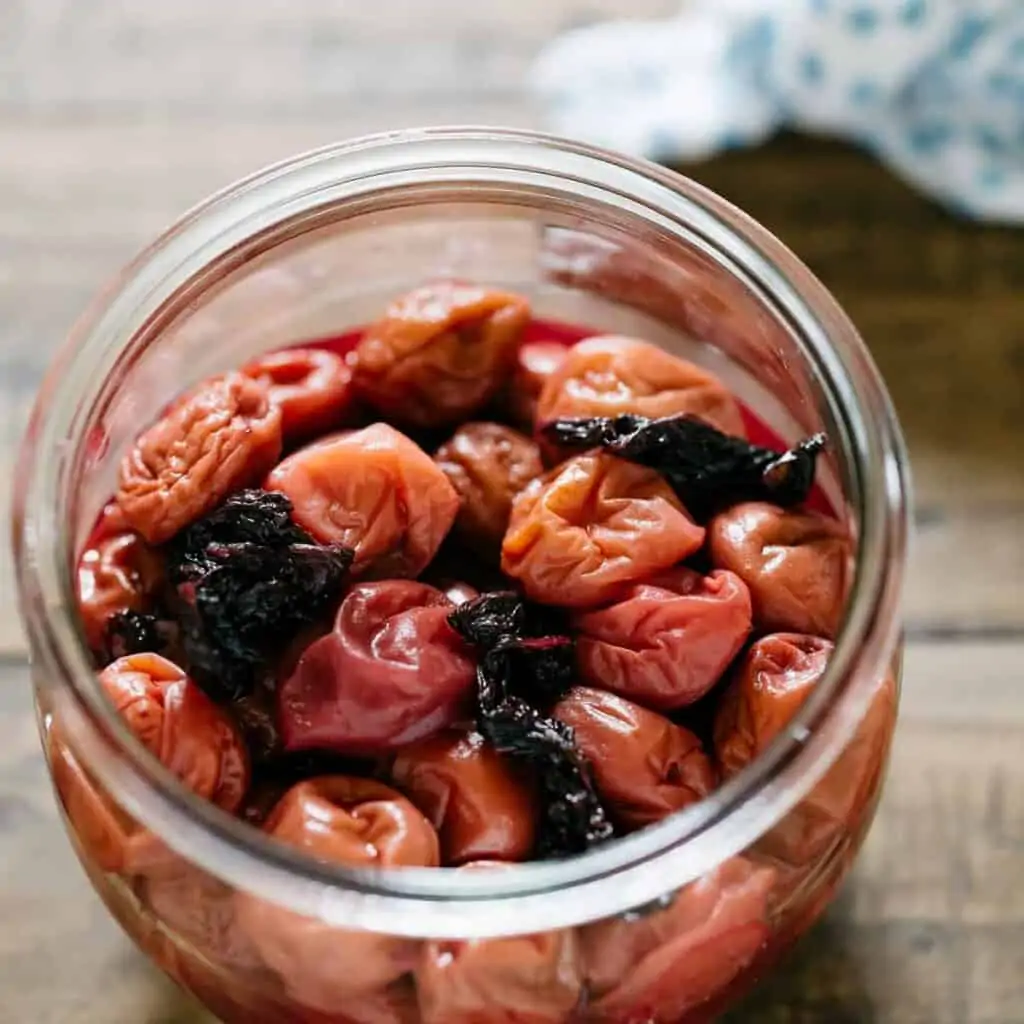
What Is Umeboshi?
Umeboshi is a traditional Japanese preserved plum. “Ume” is the Japanese word for plum fruit and “boshi” means dry. It is a traditional and popular preserved food made by pickling green and firm plums (Ao-ume) with salt then drying in the sun. It is often dyed red using purple Shiso perilla leaves. Umeboshi has been consumed historically for medicinal purposes and has often been used as a portable food in emergencies. Umeboshi taste is salty and sour because of citric acid.
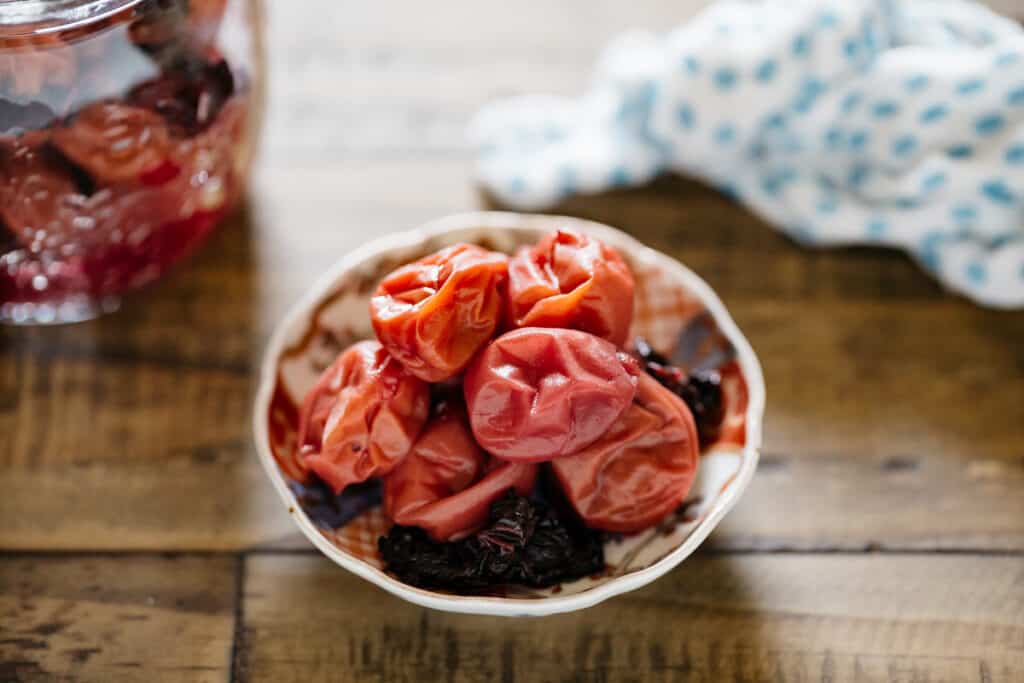
What Is Umeboshi Good For?
Apart from having a special taste, it has health benefits. The sourness of Umeboshi is due to the citric acid and Malic acid. Citric acid, which is contained in lemons and other citric fruits, promotes gastrointestinal function, promotes appetite, and improves protein digestion. Malic acid is effective in relieving fatigue. By taking both acids together it is meant to be effective for healing inflammation and promotes good gastrointestinal function.
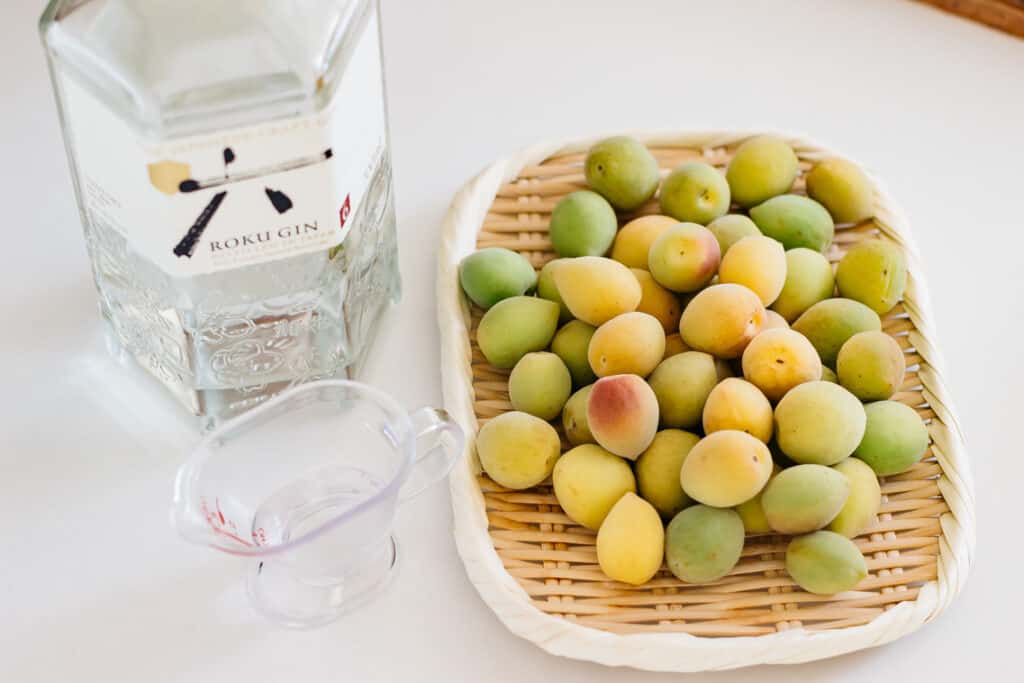
Flavor Varieties
There are a few flavor varieties in Umeboshi: Shiroboshi, Akajiso (red shiso) Zuke, Katsuo-ume, Hachimitsu-zuke, Konbu-ume, Ringo-ume, Karikari-ume etc. Shiroboshi is Ume plum pickled with salt without red shiso and Akajiso zuke is with red shiso. Katsuo-ume is what I grew up eating and is made with bonito flakes. Konbu-ume is made with kelp, Ringo-ume uses apple cider vinegar and apple juice, and Karikari-ume is made using smaller ume plums which have a crisper crunchy flesh.
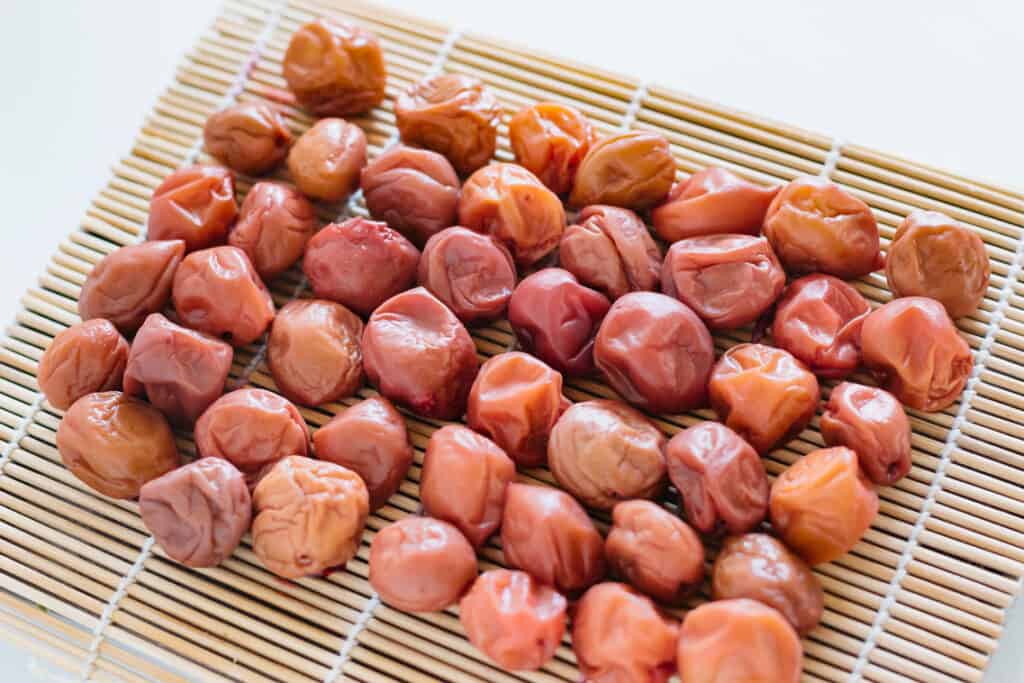
Umeboshi Usages
Umeboshi can be eaten as it is and has a variety of other uses. The liquid that is made when ume is salted is called plum vinegar which can be used as a type of vinegar for foods such as sushi and mixed with mirin to make salad dressings. By straining and crushing the umeboshi into a paste and combining it with sugar, mirin, and soy sauce can make “umeniku ae”, which can be added to salads to create more flavor. Adding umeboshi to dishes using simmered blue-backed fish (such as sardines and mackerel) can add more flavour and improve the taste.
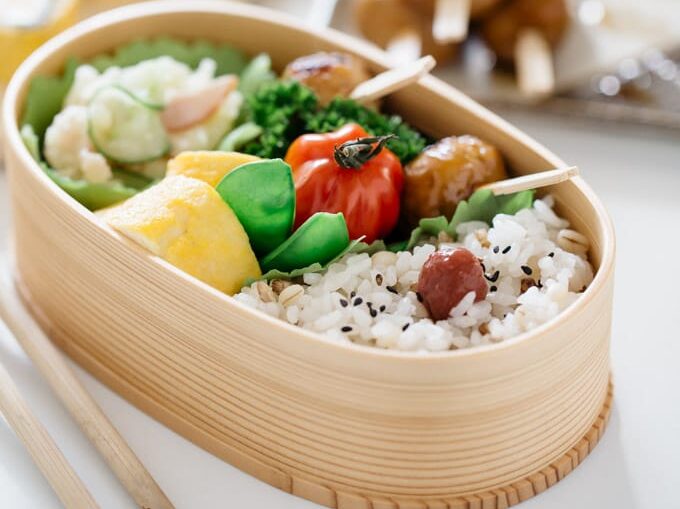
It is also used as a preservative in foods such as bento lunch and as Onigiri rice balls filling because Umeboshi has a high acidity level. Umeboshi can also be used to make soup by cooking it with shredded ginger and soy sauce. The purple shiso leaves that can be added when making the umeboshi can later be used to make yukari shiso furikake.
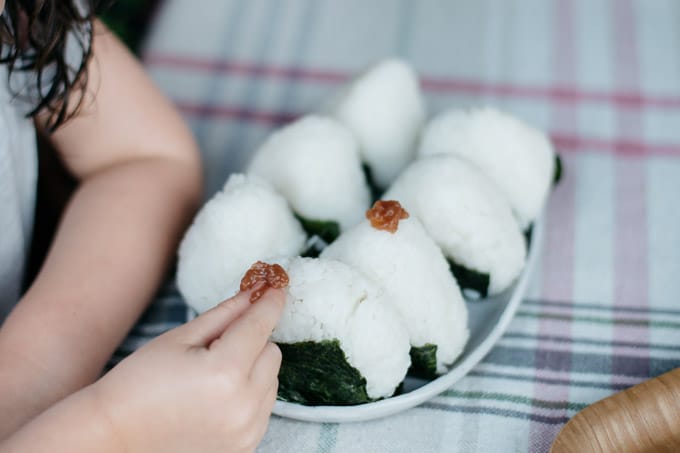
Where to Buy Umeboshi?
Umeboshi can be purchased from local Japanese grocery stores and online. However, it’s much more rewarding to make at home and is not a difficult process. The only thing you may find tricky is finding ume plums. I was lucky and found ume plums one day at my local Japanese grocery store so you may want to try searching around at Asian grocery stores near you. You can also try finding them at local Asian markets that may occur in your city on the weekends. If you want fresh ume plums then try searching around June as this is when they are in season.
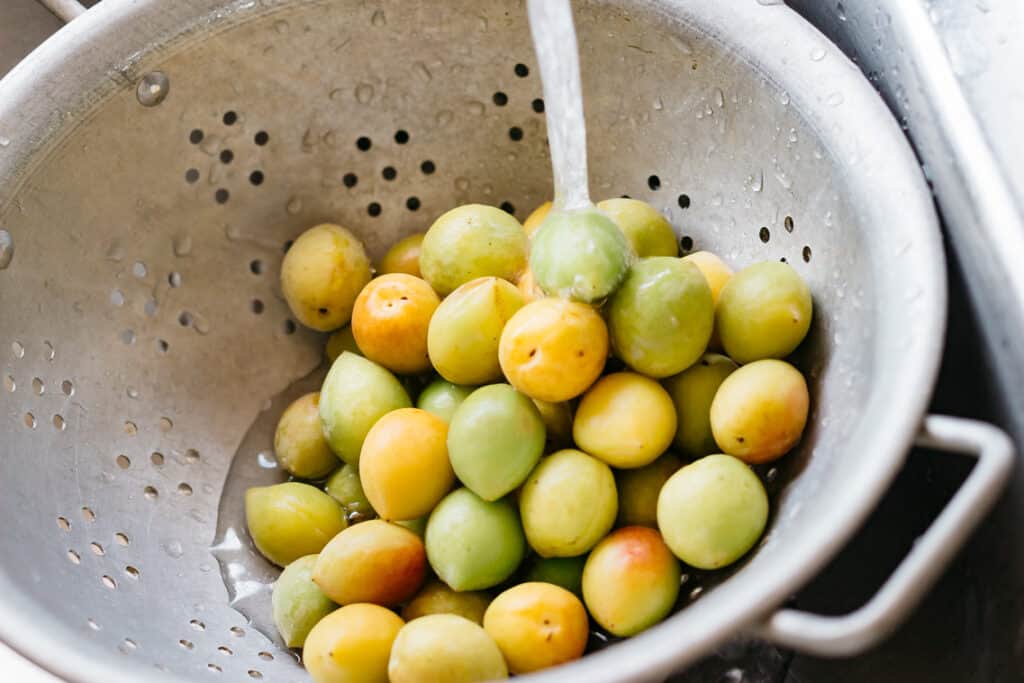
What Equipment Do I Need?
A container for pickling – avoid acid-sensitive plastic and metal containers. Choose enamel, glass or pottery containers. I used a glass jar that I bought from Ikea, which cost me like A$5. Weight – A weight is needed to apply pressure on the top of the plums. You need the same weight as the Plums. So if you have 1kg of plums, you need 1kg of weight. I had 350g of plum, so I placed 350g of baking beads into a ziplock sandwich bag and used it as the weight. A bamboo tray – to dry the pickled umeboshi and red shiso in the sun.
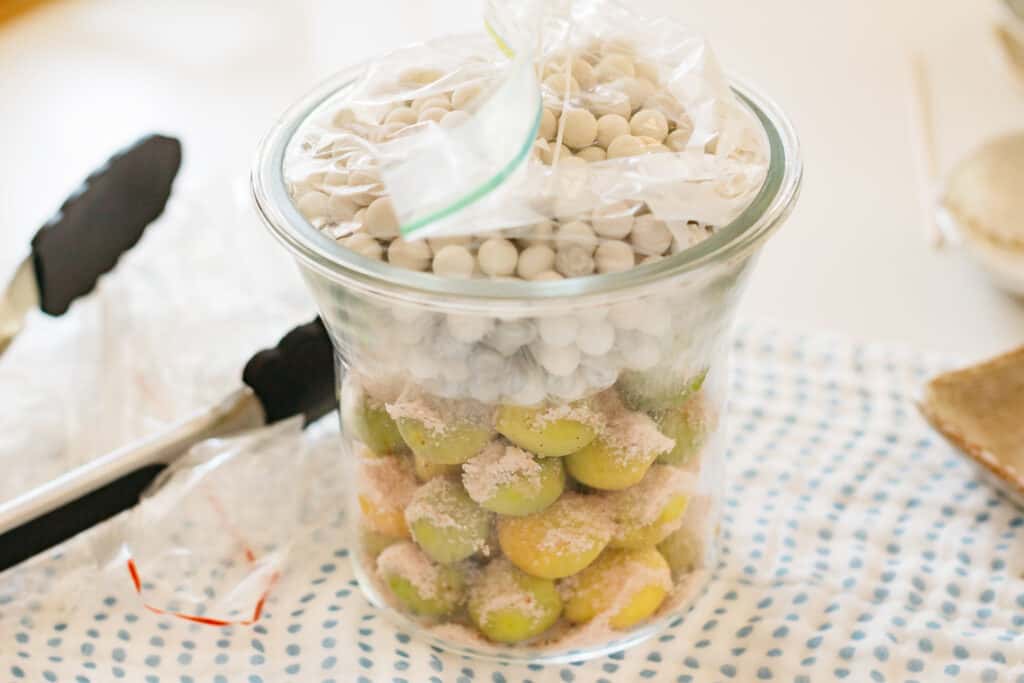
What Ingredients Do I Need?
Ume Plums
There are many types of Ume Plum fruits available in Japan. I would pick Nankō Ume, which are mainly produced in Minabe, Wakayama prefecture where I grew up. However, outside of Japan, if you can find any fresh Ume plum consider yourself lucky. You would probably not have the luxury of choosing a specific type.
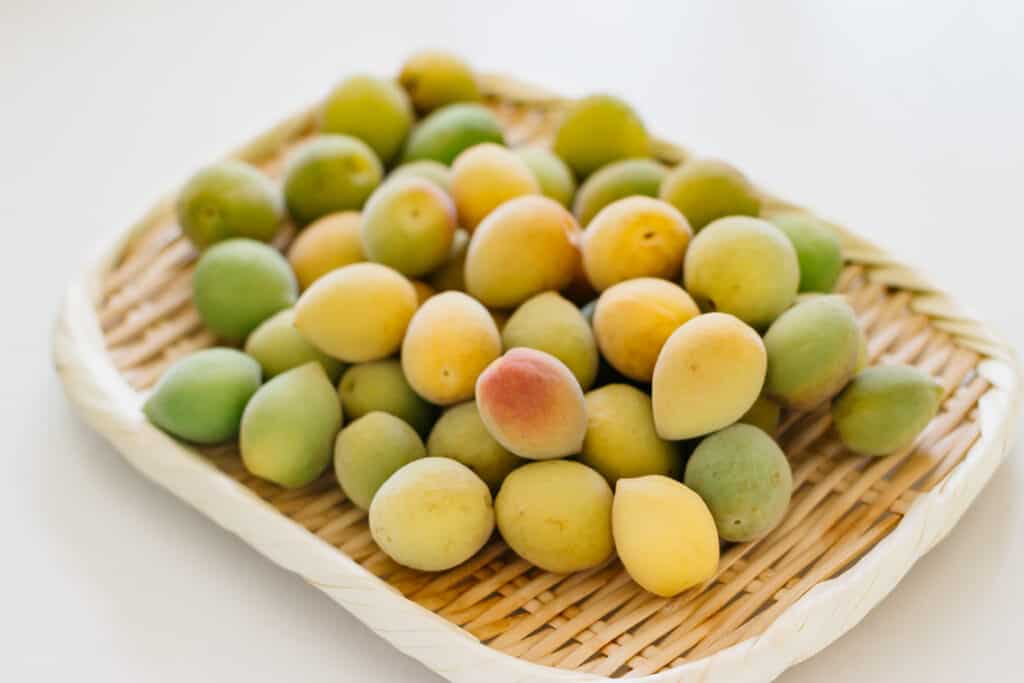
Japanese use Ume plums to make Umeshu (Plum wine), Ume syrup, Ume jam, and Umeboshi etc. Green firm Ume, which is called Ao-ume is good for making Umeshu and syrup. The ripe and yellowish plum are best suited for making umeboshi. If you have a chance to get fresh Ume plums and if it is still green and firm, leave them in room temperature till they turn yellowish in colour.
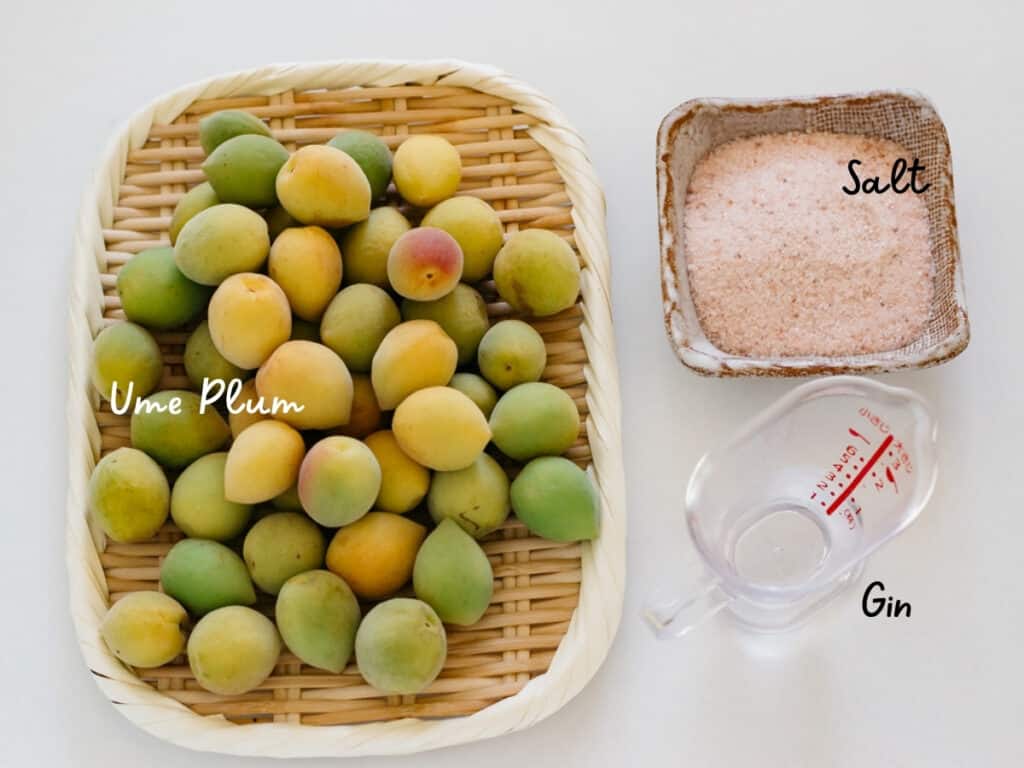
Sea Salt
Traditionally, we need salt 18% to 20% of the weight of the plums. Reducing the salt makes it easier for mould to grow. I followed the traditional way like my grandmother used to make, sticking to 20% salt. I recommend using larger grain salt which melts slowly so that makes the umeboshi taste mellow. reference: Plum Trivia by Kishū Ume Honpo

Red Shiso
If you would like to make pinkish coloured umeboshi, you can add red shiso to colour the umeboshi. It is an optional step so if you can not get red shiso, you can skip this ingredient and extra steps for adding salted red shiso. Red Shiso can be found at the local farmers market or grow them as I do.
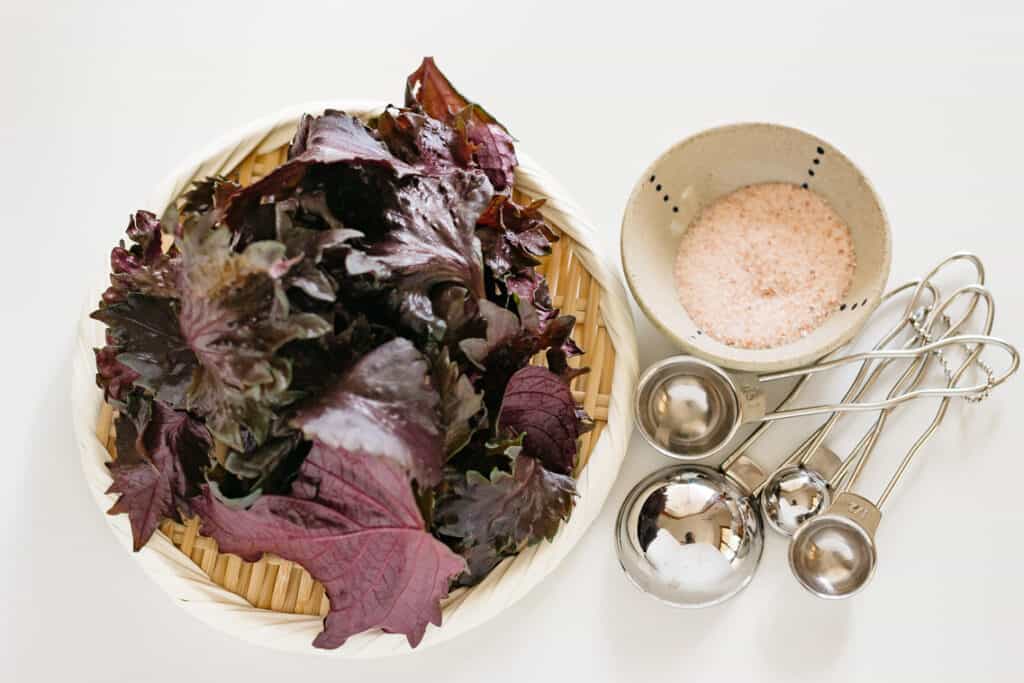
Flow of Making Umeboshi
- Make salted plums (it takes about 1 week to get Umezu, the liquid produced by pickling ume plum fruit with 20% of salt)
- Add red shiso to colour the salted plums (approximately 2 weeks)
- Sundry salted plums for three days which is called “Doyōboshi” in Japanese.
- Putting them back into the preserve container to mature. *you can eat it straight away but if you let it mature for 3 months or longer it will taste mellower. Also, you can preserve without putting them back into the umezu. In that case, the ume fruit will be dull orange in colour and will be viscous texture.

Tips to Make Umeboshi Without Fail
- Use ripe ume fruit – If you get green firm Ume fruit like I got, let them sit in the room temperature covered with newspaper till the colour turns yellowish.
- Disinfect with Shochu – though Shochu is quite expensive so I used Japaneses gin which contains 43% alcohol. You can use any 35% alcohol liquor.
- Use a minimum 18% of salt to ume plum fruit weight. Umeboshi is made with 20% salt traditionally and I usually follow that tradition. Reducing the salt amount results in making an environment that will easily grow mold and difficult to rise umezu (plum vinegar). Following this amount of salt also lets you enjoy your homemade Umeboshi for years.

How To De-salt The Umeboshi
You may be concerned about the amount of salt used to make Umeboshi. Don’t worry there is a way to de-salt it. Prepare 1L of water for about 10 umeboshi plums. Add a pinch of salt into the water and stir. Then Add 10 umeboshi plums and leave it for about 12 hours. By adding a pinch of salt, it makes it easier to remove the salt due to osmotic pressure. Drain the water well and store them in the refrigerator and eat them as soon as possible. Because using this technique the salt content is reduced to around 12-15%. Remember the lower the salt content, the shorter the shelf life. Reference: Kawashimaya how to desalt

Doyōboshi
Japanese traditionally pick 3-4 days from the dog days of the summer after the rainy season is over. Sun-drying pickled ume plum in those hot days is called “Doyoboshi” in Japanese. Because it is said that the dog days of the summer is the ideal time to sundry pickled ume plums.
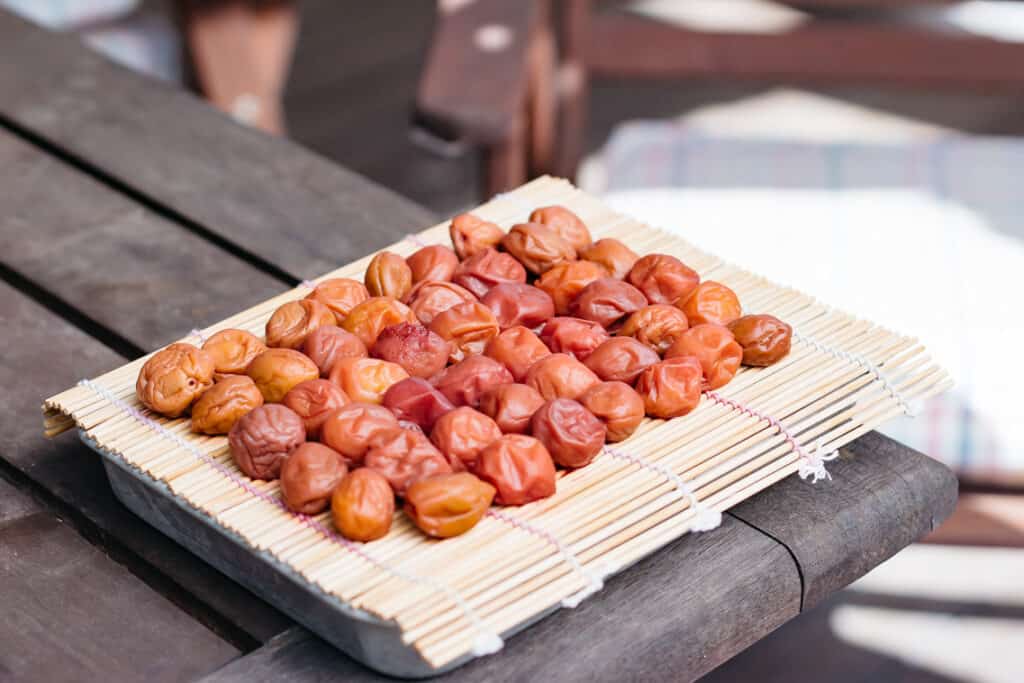
Day 1: Sundry pickled ume plums and red shiso leaves during the day time only. Turn the plums and red shiso leaves sometimes so that they are exposed to the sun from every angle. When the sun sets, set them indoors and put them back into the umezu (plum vinegar). Day 2: Repeat same as day 1 but leave them outside overnight. Day 3: Same as Day 2. As a guide, the weight of umeboshi should be about 50-60% of the original.
Related Recipes
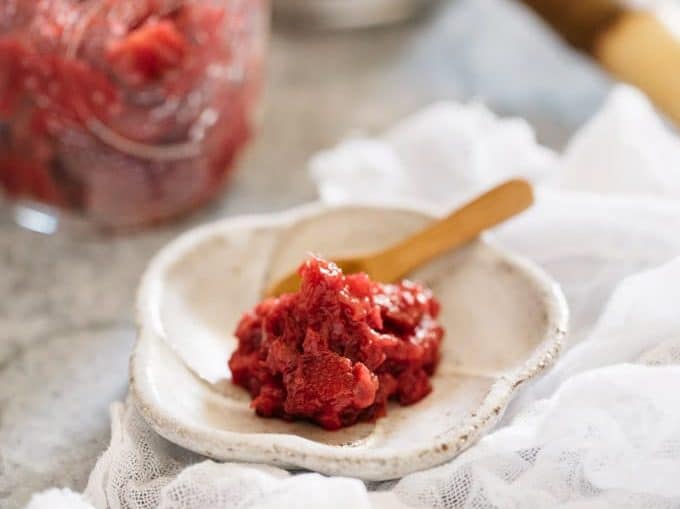
FAQ
A: Not necessarily. If you are using ripe yellowish plums, soaking in water actually makes the plums go off easily. If you are using green fruit, you could soak in water for a few hours.
A: After, because then we can avoid the water getting into where the calyx is removed.
A: By exposing it to the strong summer sun, it suppresses the growth of mold and also the moisture of the pickled plums are reduced which make a more condensed taste and flavour.
A: You can use them for making another pickles called “Shibazuke” and also you can make Yukari furikake rice seasoning from leftover shiso leaves. I am planning to have the Yukari recipe on the blog soon.
A: No it is not, the high salt content will kill any microorganisms to ferment.
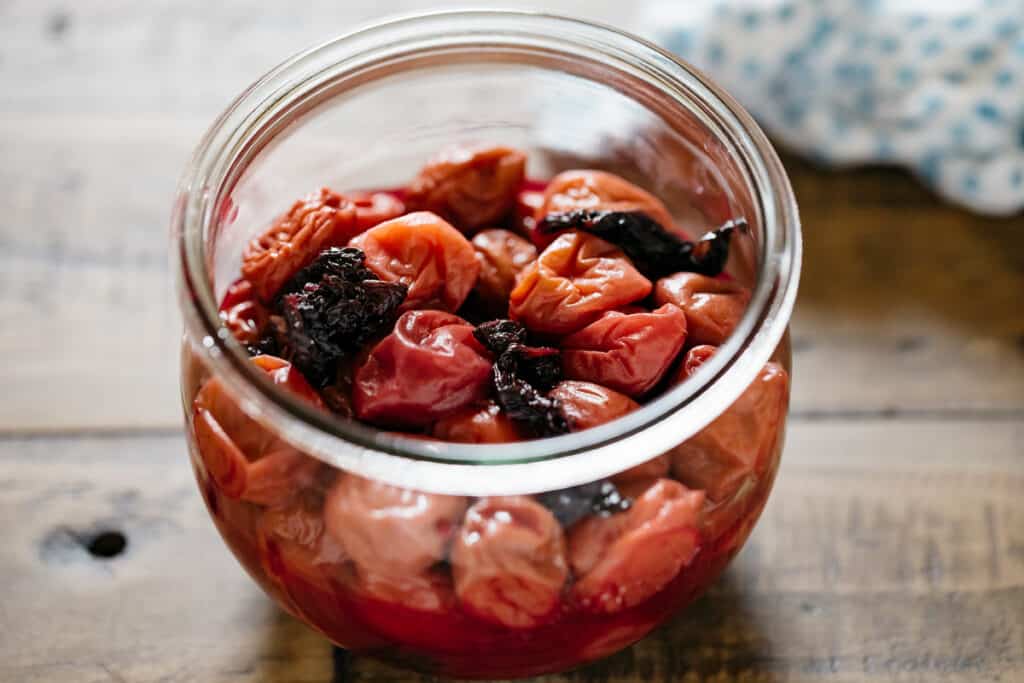
Recipe Measurement Notes
- To alter the serving size click on the serving number and move the slider left or right to adjust the quantity.
- As you move the slider the quantities of the ingredients will adjust accordingly in both imperial and metric measurements.
Stay Connected
If you like the recipe please rate the recipe and leave comments below. Also don’t forget to follow me on Youtube, Pinterest, Facebook, Twitter and Instagram. This way you keep up to date with all the latest happenings on Chopstick Chronicles. Don’t forget to Sign up for a weekly newsletter so you never miss out on new authentic delicious Japanese recipes! Sign up form is on the right-hand sidebar.
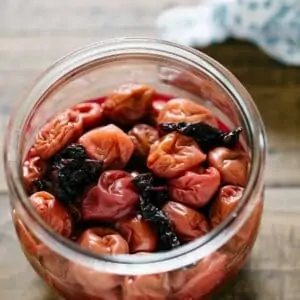
Umeboshi pickled plum
Equipment
- a preserving jar
- a skewer
- a ziplock bag
- baking beads
- a bamboo tray
Ingredients
Pickled Ume Plum
- 350 g ripe Ume plum fruit
- 1/2 tbsp Japanese gin
- 70 g sea salt
Momi Shiso (massaged red shiso leaves) for colour
- 100 g red Shiso leaves
- 2 tsp sea salt
- 1 tbsp umezu from pickled plum
Instructions
Pickled Ume Plum
- Sterilysing the preserving container by boiling in a large pot. Take them out and let it dry to set aside.
- Wash Ume Plum fruits. *1
- Pat dry the ume plum fruits with kitchen towel or cloths.
- Place the ume plum in a ziplock bag and pour over the gin to disinfect.
- Place some of the ume at the bottom of the sterilised preserving glass jar and add some of the salt. Repeat this to make layers of umeboshi and salt until the umeboshi is all used.
- Place a weight on top of the last layer. I used baking beads inside a ziplock bag as a weight.
- Store out of sunlight for a week. Check everyday if umezu (plum vinegar) is being produced and rising.
- After one week, prepare the red shiso leaves to add to the plums.
- After adding the leaves, set aside for 2 weeks.
- Pick 3 consecutive sunny days to dry the umeboshi.
- On day one remove the umeboshi from the jar and place onto a bamboo tray to dry. Make sure to leave a gap so they aren't touching. Squeeze the liquid out of the shiso leaves and spread the leaves out on the tray to dry too. Bring in the tray at night and place the leaves and the plums back into the jar with the liquid.
- On day two repeat the same as day one. However, do not put the plums and leaves back into the jar. Leave them on the tray.
- On day three repeat the same as day two. *3
Momi Shiso (massaged red shiso leaves) for colour
- Wash the shiso leaves and drain the water as much as you can.
- Sprinkle half of the salt amount on top of the leaves.
- Toss the salt and shiso leaves together then massage the leaves with your hands.
- Discard the dark purple liquid that comes out.
- Sprinkle the remaining half of the salt over the shiso leaves and massage again. *2
- Squeeze out the dark purple liquid from the leaves.
- Place the shiso leaves into a small mixing bowl.
- Add 1 tbsp of umezu (plum vinegar) from the jar of plums.
- Add the leaves to the jar of umeboshi and leave for another 2 weeks.
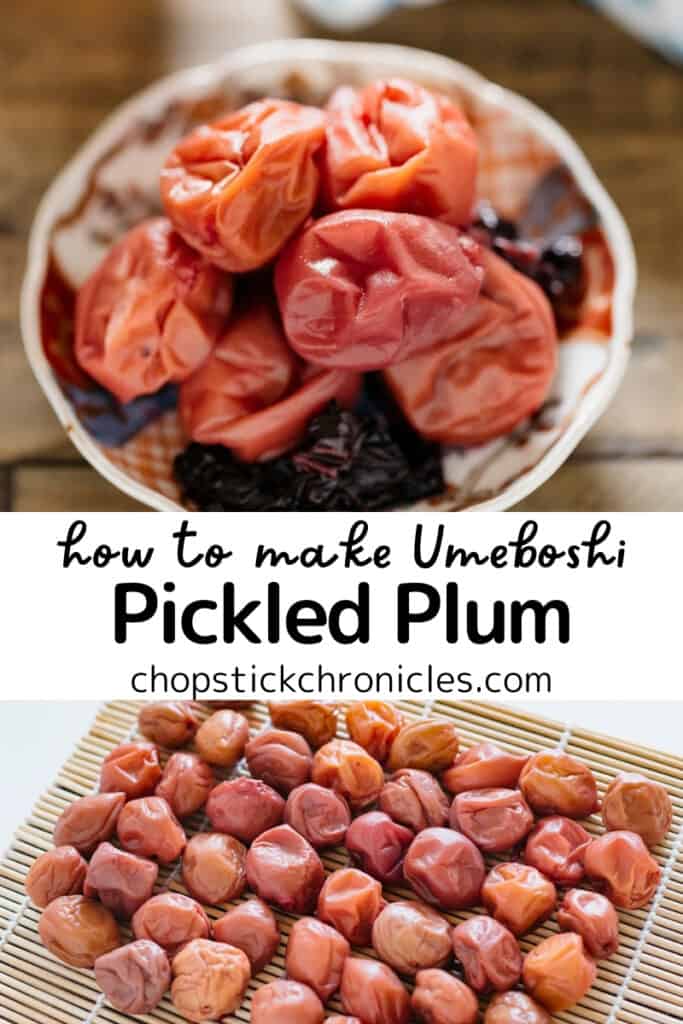
Any tips on where to find Ume plums in Brisbane? I’d love to try making my own. When are they in season? Thanks!
Hi Michael, I used to get ume from a lady in southside she has a facebook page called “ブリスベンで梅狩り”. It is closed group. You can request to join and they will let you know when you can pick. She has about 40 trees if my memory is correct. And yes it is season now.
Strange
I always thought these were a fermented food.
I’ve grown some purple Shiso this year so had a go at making something similar.
I’m in the UK so used local plums (probably sweeter than yours)
My mixture has fermented and is actively bubbling.
I’ll report back when it’s ready
Hi Colin, Umeboshi is salted plum and because the amount of salt used to pickle, the salt will kill all microorganisms, therefore will not ferment.
Once the use are salted in the jar with the weight on top, should the jar be sealed?
Hi Annie, yes.
I put up some umeboshi a year ago, I did not dry them before packing them for storage. Am I sunk?
This year I may want to try hachimitsu umeboshi. How much and when do I add the honey?
Thank you I will let you know how it goes!!
Hi Dorothy, I have never made hachimitsu umeboshi but it seems that you need to add a mixture of honey, mirin, water, vinegar and water when the umeboshi are made.
Hi! I just stumbled across your page and am keen to try this recipe. Thankyou so much for sharing it!
Hi Michelle, you are welcome 😀
That is a very clear recipe, thank you,
We made a video about a farmer in Shizuoka, making his own umeboshi, all is subtitled. Would be happy if you could take a look !
https://www.youtube.com/watch?v=uqgVOnLjyXM&ab_channel=JapanecdoteShizuoka
this is my second time using this recipe. it is impossible to fine the right ume plum where I am in australia, but last year there was a big storm which knocked all my green plums off the tree! using a red sweet plum, the umeshu is very aromatic and umeboshi much more sweet than a traditional one, but I like it a lot. I definitely encourage people to try themselves even if they do not have traditional ume plums available. this year, I have sour red plums found along a local river, and the umeshu is a gorgeous pink colour and smells amazing. very excited to see how different or same they will be!
Wow Grace, that sounds fantastic!
Thank you for sharing this recipe, I like it so much salty sour taste of Umeboshi..
Please clarify: typically, after partial sun drying to approx 50% original weight, are the umeboshi plums then returned to the umezu plum “vinegar” for long term storage? THanks!
Hi Alex, yes.
I am about the dry my plums, which are red from my tree, and have been marinating for one month in the salt, to which I added about 20% more sugar, and a Chinese “Five Spice” blend to make the licorice-flavored dried plums. I do not understand this step eithet, and won’t return the plums to the liquid. I mainly checked in here mainly to see uses for the marinade. I’m also probably going to dry in the oven (8-10 hours, door cracked open with spoon) if I can get it down to 90 degrees centigrade.
Hello!
I have had my pickle going for about 3 weeks, but being unable to get red shiso anywhere local I had to order from Japan. The dried leaves that I will rehydrate and pickle won’t arrive for 2-4 weeks, which will push my ume pickle past 1 month.
Is there any problem with pickling the ume past 1 month, as long as no mold forms?
Thanks a bunch!
Hi Taylor, using shiso is adding colour. If you don’t have it you can make Umeboshi without shiso. Japanese make Umeboshi without shiso too. Mold will not form if you followed minimum 18% salt of the weight of Ume plums.
I grew up in Japan in the good old days of Showa not to give my age away but the homemade umeboshi was always served.
I wished I had my mother’s recipe but what she did was pack it in some container with honey in it. I am making some right now in Georgia with the two trees I have.
Thank you for the recipe! After three days of drying, could mold form if I put the jar of ume at room temperature where the climate is warm? Will it be better in the fridge?
Hi Nita, because of the salt amount, I think it should be fine in room temperature but you can keep it in fridge too.
Thank you! I’m on the third day of drying process now! 🙂
Hi Nita, Cool, I am making a batch for this year too now.
Hi! I’m addicted to Ume plum Sauce(!!) in my salads but live in a country where it’s not sold. However, I can buy Ume plums here.
My question is how can I make Ume plum sauce from ready pickled Ume plums? I’d like to make it at least a week ahead if possible so I don’t have to make every time. I’m running out of my supply and am desperate. Thank you!!
Hi Rita, thank you for asking and excellent rating. Is ume plum sauce that you are after, made out of Umeboshi?
Hey Rita:
Umeboshi Paste is a Japanese red paste made from puréed Umeboshi.
It can be bought in tubes or bottles.
To make your own, just mash Umeboshi.
Thank you for posting these simple instructions! A few years ago I made anzuboshi (from apricots) but the liquid that came out of them was super thick. Is this because of the pectin in apricots (assuming it has some pectin – the same thing happens when I make salt-preserved lemons)? I’m curious if the resulting liquid is nothing like ume vinegar when making regular umeboshi. I have to confess I’m a little scared to even try the anzuboshi because the first time I tried umeboshi it was so sour and salty it was slightly offputting 😛
Thank you Claudia for sharing your experience with apricot.
Thanks you for sharing this. Love your site.
You are welcome 😀
This looks amazing!!!! Cannot wait to try it! I’ll report back! Thanks u
You are welcome.
I just made this and it is wonderful! It is so easy. Thanks for sharing this fabulous recipes!